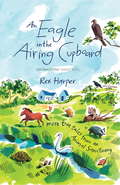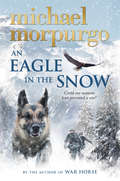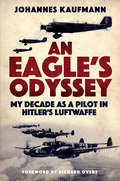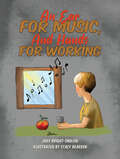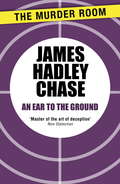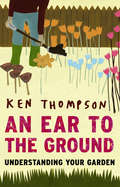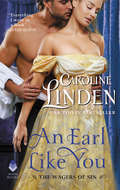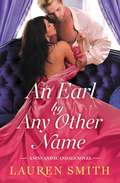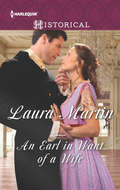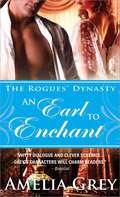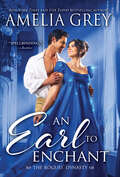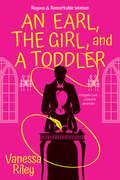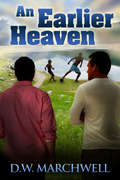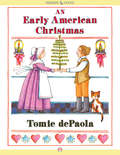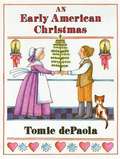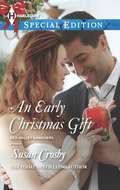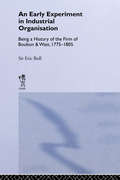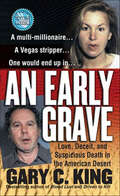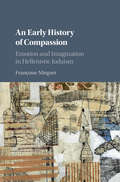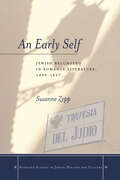- Table View
- List View
An Eagle in the Airing Cupboard
by Rex HarperAN EAGLE IN THE AIRING CUPBOARD picks up where Rex Harpers first book, AN OTTER ON THE AGA, left off. It follows the fortunes of the Cornish RSPCA centre through one of its most testing twelve months. Once more it is a mixture of funny, touching and sometimes moving animal stories. And once more it features a cast of unforgettable characters, like Alfie and Blue, two hideously mistreated greyhounds that are rehabilitated at the farm, as well as the return of old favourites from Rex's first book, including his loyal dog Moss. Throughout, Rex evokes the sights, smells, sounds and spirit of the Cornish countryside in all its timeless beauty. He also encounters sickening cases of animal cruelty committed by humans unfit to care for any living thing. Funny, warm and evocative, it is a book that is, once more, set to melt and occasionally break the hearts of animal lovers everywhere.
An Eagle in the Snow
by Michael MorpurgoEngland, 1940. Barney’s home has been destroyed by bombing, and he and his mother are traveling to the countryside when German planes attack. Their train is forced to take shelter in a tunnel and there, in the darkness, a stranger— a fellow passenger—begins to tell them a story about two young soldiers who came face to face in the previous war. One British, one German. Both lived, but the British soldier was haunted by the encounter once he realized who the German was: the young Adolf Hitler.The British soldier made a moral decision. Was it the right one? Readers can ponder that difficult question for themselves with Michael Morpurgo's latest middle-grade novel An Eagle in the Snow.
An Eagle's Odyssey: My Decade as a Pilot in Hitler's Luftwaffe
by Johannes KaufmannThe first English translation of one German military pilot&’s experience before, during, and after World War II flying for the Third Reich. Johannes Kaufmann&’s career was an exciting one. He may have been an ordinary Luftwaffe pilot but he served during an extraordinary time with distinction. Serving for a decade through both peacetime and wartime, his memoir sheds light on the immense pressures of the job. In this never-before-seen translation of a rare account of life in the Luftwaffe, Kaufmann takes the reader through his time in service, from his involvement in the annexation of the Rhineland, the attack on Poland, fighting against American heavy bombers in the Defense of the Reich campaign. He also covers his role in the battles of Arnhem and the Ardennes, and the D-Day landings, detailing the intricacies of military tactics, flying fighter planes and the challenges of war. His graphic descriptions of being hopelessly lost in thick cloud above the Alps, and of following a line of telegraph poles half-buried in deep snow while searching for a place to land on the Stalingrad front are proof that the enemy was not the only danger he had to face during his long flying career. Kaufmann saw out the war from the early beginnings of German expansion right through to surrender to the British in 1945. An Eagle&’s Odyssey is a compelling and enlightening read, Kaufmann&’s account offers a rarely heard perspective on one of the core experiences of the Second World War.
An Ear for Danger (The Three Investigators Crimebusters #5)
by Marc Brandel[from the back cover] "Sounds like a real blast! Jupiter Jones has just won a free stay at a Mexican ranch, and he's hearing warning bells. The contest he entered was just too easy. Unable to resist the sound of mystery, Jupe accepts the prize--never dreaming what trouble will flare up in Mexico for himself and his sidekicks Pete and Bob. For the beautiful ranch smolders with intrigue, and the Three Investigators get trapped in the middle of it. When a trail of treasure and treachery beckons them into the mountains, they don't dare say no. But can they talk their way out of danger before their dynamite vacation blows to bits? RL: 5.1" In the Crimebusters series The Three investigators are seventeen with girlfriends, jobs and their own cars. Stocky Jupe is still stocky and the brains of the outfit. Handsome, girl magnet Bob, who works with rock bands still keeps records and does much of the research, and between dates, athletic Pete is ready for action. Check out these sometimes funny, action driven, danger and adventure filled mysteries in the Bookshare collection including #1 Hot Wheels, #2 Murder To Go, #3 Rough Stuff, #4 Funny Business, #6 Thriller Diller, #7 Reel Trouble, #9 Foul Play, #10 Long Shot, #11 Fatal Error and #12 Brain Wash. This series gets better and better! If you like mysteries with teen investigators don't miss the original 3 Investigators series, the complete 43 novel set in the Bookshare collection starting with #1. The Secret of Terror Castle , #2. The Mystery of the Stuttering Parrot and #3. The Mystery of the Whispering mummy, ending with the last 3 books, #41. The Mystery of the Creep-Show Crooks, #42 The Mystery of Wrecker's Rock and #43 The Mystery of the Cranky Collector.
An Ear for Music, And Hands for Working
by Judy Bright-EnglishJust imagine being a young boy sitting behind your desk at home, and every morning you hear music and the sound of marching feet.But you&’re too short to see over the windowsill. The music passes by, and you wonder what it would be like to play with them. Then a gift from his housekeeper and some good news from his father gives this young boy a chance.
An Ear to the Ground
by James Hadley ChaseThe Esmaldi necklace was worth about $350,000: one hundred matched diamonds the size of garden peas, set in platinum. The sort of necklace people would murder for ...And Al Barney, beachcomber and layabout, knew its history - a tale of hate, jealousy and violence; of beautiful, wanton women and the most cunningly devised jewel robbery ever.
An Ear to the Ground (Murder Room #53)
by James Hadley ChaseThe Esmaldi necklace was worth about $350,000: one hundred matched diamonds the size of garden peas, set in platinum. The sort of necklace people would murder for ...And Al Barney, beachcomber and layabout, knew its history - a tale of hate, jealousy and violence; of beautiful, wanton women and the most cunningly devised jewel robbery ever.
An Ear to the Ground: Understanding Your Garden
by Ken ThompsonHow did plants get to be the way they are? Why do they have pretty flowers? How different would things have been if the wrong kind of pollinators had got the upper hand? Why are Latin names so complicated, and why Latin anyway? Why is a weed-free lawn an ecological impossibility?This entertaining book gives the answers to these questions and many more. It shows how a little botanical knowledge can bring not just better results but peace of mind, and that losing sleep over such traditional gardening bogeys as weeds, pests and pruning is not necessarily the best course. In this new edition Ken Thompson grabs the opportunity to explain why any old plant will do for companion planting - but also that it can do as much harm as good - and why planting by the moon is complete and utter nonsense.
An Earl Like No Other
by Wilma CountsA handsome earl discovers his new housekeeper is full of surprises in this Regency romance by the author of Rules for an Unmarried Lady.When all seemed lost . . . Katherine Gardiner, a young English widow, has only one dream: to protect her son—a future duke—from her merciless father-in-law. Determined and desperate, she has no option but to take the guise of a housekeeper and escape to Yorkshire where the only hope is the enigmatic Earl of Kenrick . . .. . . love saved the day In all his years spent roaming the world, Jeremy Chilton never braced himself for the burden of a much-damaged inheritance. Now, the new Earl of Kenrick must save his family legacy and raise his motherless young daughter as a proper English lady. His only salvation is his beautiful housekeeper, Kate. But as her secrets unravel, much that is puzzling about her falls into place. No wonder the Earl has caught himself imagining her more wife than employee. Clearly she belongs at Kenrick—safe in his arms. Now, if only he can convince her to agree . . .
An Earl Like You: The Wagers of Sin (The Wagers of Sin #2)
by Caroline LindenWhen you gamble at love . . .When Hugh Deveraux discovers his newly inherited earldom is bankrupt, he sets about rebuilding the family fortune—in the gaming hells of London. But the most daring wager he takes isn’t at cards. A wealthy tradesman makes a tantalizing offer: marry the man’s spinster daughter and Hugh’s debts will be paid and his fortune made. The only catch is that she must never know about their agreement . . .You risk losing your heart . . .Heiress Eliza Cross has given up hope of marriage until she meets the impossibly handsome Earl of Hastings, her father’s new business partner. The earl is everything a gentleman should be, and is boldly attentive to her. It doesn’t take long for Eliza to lose her heart and marry him.But when Eliza discovers that there is more to the man she loves—and to her marriage—her trust is shattered. And it will take all of Hugh’s power to prove that now his words of love are real . . .
An Earl by Any Other Name (Sins and Scandals #1)
by Lauren SmithAn earl in the streets, a rogue in the sheets . . .Leopold Graham, Lord Hampton, was never a man to let propriety stand in the way of his pursuit of pleasure. Hedonism is his only desire in life---until his father's death saddles him with debts that threaten to bankrupt the entire family. Now the only thing that stands between him and utter ruin is marriage to a proper, and preferably wealthy, young lady.Ivy Leighton is no sweet English rose. Perhaps it's her gypsy roots, but she would rather make a spectacle of her independent spirit than sit quietly on the sidelines. If that means that the only place she'll ever have in society is firmly on the shelf, then so be it. But when Ivy runs into the handsome, rakish Leo who's looking for a respectable, well-bred wife, she can't stop thinking about the troubles they can get into. Now she just has to convince him that a life with her is really what he needs. 35,000 words
An Earl for the Shy Widow: The Widows Of Westram (The Widows of Westram #2)
by Ann LethbridgeThe new earlAnd the lady he should resist!Part of The Widows of Westram: Having left the army to take up the title of Earl of Longhurst, Ethan feels the weight of his new responsibilities. He was brusque with the woman picking blackberries, only to find she’s his neighbor Lady Petra, who helps him despite his gruffness. A wealthy bride would save his estate, but all he can think about is this shy, kind and penniless widow!The Widows of Westram miniseriesBook 1 — A Lord for the Wallflower WidowBook 2 — An Earl for the Shy WidowBook 3 — A Family for the Widowed Governess — coming soon!“A really fun romance that should leave a smile on your face”— A Cat, a Book and a Cup of Tea on A Lord for the Wallflower Widow“I could not put it down until I finished reading it … The story is just so good.”— Goodreads on A Lord for the Wallflower Widow
An Earl in Want of a Wife: The Secrets Of Wiscombe Chase An Earl In Want Of A Wife Lord Crayle's Secret World (The Eastway Cousins #1)
by Laura MartinA marriage of convenience...or desire? The Earl of Burwell needs a wife! The woman who broke Daniel's heart has been blackmailing him, so to protect his son from the horrors of illegitimacy, he must find a rich bride... Temporarily posing as her heiress cousin, plain, poor orphan Lizzie Eastway knows her popularity is due only to her supposed dowry-no one could ever love the real her. And disclosing her true identity seems heartbreakingly impossible when Lizzie sees the spark of genuine desire in dashing Lord Burwell's eyes!
An Earl to Enchant
by Amelia GreyHe's determined not to be a hero... Lord Morgandale is as notorious as he is dashing, and he's determined no woman will tie him down. But from the moment Arianna Sweet appears on his doorstep, he cannot resist the lure of her fascinating personality, exotic wardrobe, and tempting green eyes... She has a deadly secret... Arianna Sweet never imagined the significance of her father's research until after his untimely death. Now she is in possession of his groundbreaking discovery, one that someone would kill for. She can't tell Lord Morgandale her secret, but she knows she needs his help, desperately...
An Earl to Enchant: The Rogues' Dynasty
by Amelia GreyNew York Times and USA Today bestselling author Amelia Grey brings all the charm and allure of Regency England in this sparking historical romance featuring:A family dynasty in danger of falling apartA secret someone is determined to keep buriedA lady willing to do anything to honor her familyAnd the handsome rake resolved to protect herPerfect for fans of the Bridgerton seriesMiss Arianna Sweet's beloved father discovered a formula that could be the cure for consumption. But before he could make his discovery known, he died suddenly and under suspicious circumstances. While determined to bring his formula to the attention of London's prominent medical society, Arianna suffers a series of increasingly dangerous accidents and is forced to conclude that someone is after the formula, and her very life may be in danger.Rushing to the countryside to her father's old friend Lady Elder, Arianna is shocked to find that she must rely on that venerable lady's grandson, Lord Morgandale—one of society's most notorious and deadly handsome rakes…"Amelia Grey never fails to entertain."—KAT MARTIN, New York Times bestselling author"Captivating."—Fresh Fiction for Never a Bride"Charming and unforgettable."—The Long and Short of It for A Gentleman Never Tells"What romance dreams are made of."—Love Romance Passion for A Dash of Scandal
An Earl to Save Her Reputation (Mills And Boon Historical Ser.)
by Laura MartinA convenient betrothal“It will save us both from scandal.”Widowed three times over, Lady Anna Fortescue is used to ignoring the wagging tongues of the ton. After finding herself in a compromising position with handsome bachelor Lord Harry Edgerton, to avoid scandal she ends up engaged again. The arrangement may be one of convenience, but as Anna finds herself unable to resist Harry’s charms, she realizes the betrothal may have its benefits…
An Earl, the Girl, and a Toddler: A Remarkable and Groundbreaking Multi-Cultural Regency Romance Novel (Rogues and Remarkable Women #2)
by Vanessa RileyAn OMag.com & Bibliolifestyle Most Anticipated Romance of 2021A PopSugar Best Romance of AprilA Publishers Weekly Top 10 Romance of Spring 2021 A witty and moving story from the acclaimed author of A Duke, the Lady, and a Baby, about the lengths to which a woman will go for the love of her child…and the love of a man who knows her worth. Breaking with traditional Regency rules and customs, Vanessa Riley pens an unforgettable story perfect for fans of Julia Quinn&’s Bridgerton, Evie Dunmore, and Eloisa James looking for something fresh and stirring! &“Bridgerton fans, if you read just one book on this list, make sure it's Vanessa Riley's terrific An Earl, the Girl, and a Toddler.&” – Popsugar &“Elaborate storytelling…a more diverse Regency world than is traditionally found. Well-researched, with a fascinating author's note at the end…A historical romance of impressive heft.&” – Kirkus Reviews &“Fans of Shonda Rhimes&’ adaptation of Julia Quinn&’s Bridgerton books will devour this series.&” – Booklist STARRED REVIEW &“Move over, Bridgertons. There&’s a new set of scandalous aristocrats waiting to take London society by storm.&” – Library Journal Masterminded by the ton's most clever countess, the secret society The Widow&’s Grace helps ill-treated widows regain their reputations, their families, and even find true love again—or perhaps for the very first time . . . Surviving a shipwreck en route to London from Jamaica was just the start of Jemina St. Maur's nightmare. Suffering from amnesia, she was separated from anyone who might know her, and imprisoned in Bedlam. She was freed only because barrister Daniel Thackery, Lord Ashbrook, was convinced to betray the one thing he holds dear: the law. Desperate to unearth her true identity, Jemina&’s only chance is to purloin dangerous secrets with help from The Widow&’s Grace—which means staying steps ahead of the formidable Daniel, no matter how strongly she is drawn to him . . . Married only by proxy, now widowed by shipwreck, Daniel is determined to protect his little stepdaughter, Hope, from his family&’s scandalous reputation. That&’s why he has dedicated himself not just to the law, but to remaining as proper, upstanding—and boring—as can be. But the closer he becomes to the mysterious, alluring Jemina, the more Daniel is tempted to break the very rule of law to which he's deevoted his life. And as ruthless adversaries close in, will the truth require him, and Jemina, to sacrifice their one chance at happiness? RAVES FOR A DUKE, A LADY, AND A BABY &“One of the best historicals I&’ve read in years.&” —Kristan Higgins, New York Times bestselling author &“Smart and witty . . . the perfect historical read.&”—Julia Quinn, #1 New York Times bestselling author &“Expertly crafted romance.&” —Publishers Weekly, STARRED review &“Riley gifts readers a sparkling love story&” —Entertainment Weekly
An Earlier Heaven (Good to Know #2)
by D. W. MarchwellSequel to Good to KnowGood to Know: Book TwoIt's been almost a year since William lost his parents and left the only life he knew for a new home in Canada. But now there's nothing William loves more than being with his two new dads. His uncle Jerry McKenzie adopted him and then married David Loewenberger, and William is learning what it means to be part of a family. But despite all the love and care the two men lavish on him, William is still lonely. It isn't until he meets Cory, a high school student who is helping coach his soccer team, that William begins to think about what it would be like to have a brother. Little does he know that he might just get his wish, but first William will learn some very important lessons about love and loss.
An Early American Christmas
by Tomie DePaolaA new family shows the neighborhood what Christmas is all about. In this small New England village, no one makes much of a fuss about Christmas--until a new family moves in, that is. The family works tirelessly to prepare for the holiday: decorating the house, hand-dipping candles, baking mounds of delicious cookies, and carving nativity pieces. In the end, these new neighbors show their small village how to celebrate the holiday in a very special way. This fixed-layout ebook, which preserves the design and layout of the original print book, features read-along narration.
An Early American Christmas
by Tomie Depaola"Once, a long time ago in the small New England village, not one single candle could be seen in the windows at Christmastime. Not an evergreen wreath on the door. Not a Christmas tree in the parlor. Not even a Christmas song could be heard in the night air..."
An Early Christmas Gift
by Susan CrosbyHistory certainly is repeating itself, romantically speaking, in USA TODAY bestselling author Susan Crosby's third book in her Red Valley Ranchers miniseries! The Capulets and the Montagues had nothing on the Ryders and the Morgans! But despite the fact that each one was from one of the rival ranching families, Jenny Ryder and Win Morgan had a passionate summer affair four years ago-one that resulted in pregnancy. They got married and promptly lost the baby. Heartbroken, Jenny let herself be talked into divorcing Win...without ever having revealed the marriage to her family-or his. Now Jenny's back, and one impulsive night means that Jenny and Win are about to be parents again! This time, they have to fess up. Their future happiness and child depend on it. But Win is keeping his own secret-that "divorce" he and Jenny supposedly got might not be worth the paper it (wasn't!) printed on....
An Early Experiment in Industrial Organization: History of the Firm of Boulton and Watt 1775-1805 (Reprints Of Economic Classics Ser.)
by Eric RollFirst Published in 1968. Routledge is an imprint of Taylor & Francis, an informa company.
An Early Grave: Love, Deceit, and Suspicious Death in the American Desert (St. Martin's True Crime Classics)
by Gary C. KingOn September 17, 1998, police found Las Vegas gambling magnate Ted Binion lying dead on the floor of his palatial home, an empty bos of Xanax beside him. The police had been called by Binion's live-in lover, Sandra Murphy, 23, a California girl who had been working in a Vegas strip club when Binion had first met her. At first it seemed it was a fatal drug overdose that killed the handsome multi-millionaire. But was it?A few days later, Binion's "friend" Rick Tabish was arrested for trying to break into a vault where the eccentric millionaire had stored seven million dollars' worth of silver bars and coins. Family members hired ex-homicide detective-turned-private investigator Tom Dillar to start digging into the case. Dillard turned over the evidence he collected to Las Vegas police. What they found led to Binion's death being ruled a homicide and Murphy and Tabish's arrest for murder.The state said they were greedy lovers who'd conspired to kill Binion before they could strike Murphy out of his will, while the defense claimed that his vengeful family was trying to railroad Murphy to keep her from inheriting her fair share of the estate. The two sides collided in court, amid lurid charges and countercharges of physical abuse, drug use and illicit passion, in what became the Southwest's Murder Trial of the Century!
An Early History of Compassion: Emotion and Imagination in Hellenistic Judaism
by Françoise MirguetIn this book, Françoise Mirguet traces the appropriation and reinterpretation of pity by Greek-speaking Jewish communities of Late Antiquity. Pity and compassion, in this corpus, comprised a hybrid of Hebrew, Greek, and Roman constructions; depending on the texts, they were a spontaneous feeling, a practice, a virtue, or a precept of the Mosaic law. The requirement to feel for those who suffer sustained the identity of the Jewish minority, both creating continuity with its traditions and emulating dominant discourses. Mirguet's book will be of interest to scholars of early Judaism and Christianity for its sensitivity to the role of feelings and imagination in the shaping of identity. An important contribution to the history of emotions, it explores the role of the emotional imagination within the context of Roman imperialism. It also contributes to understanding how compassion has come to be so highly valued in Western cultures. The book approaches Judeo-Hellenistic literature from the innovative perspective of emotions and offers an in-depth study of pity/compassion in regard to its historical development and to its different social functions, especially in regard to the construction of identity, making it appealing to scholars of ancient Judaism and Christianity who are seeking alternative approaches. The book also explores the textual/imaginative foundation on which early Christians draw in their discourses on compassion, making it appealing to scholars of Christianity who deal with compassion and other related virtues/emotions. The book explores the history of a popular emotion in contemporary Western societies: compassion - making it appealing to those interested in the larger history of compassion, especially in regard to its transformation into a virtue and its political uses.
An Early Self: Jewish Belonging in Romance Literature, 1499-1627
by Susanne Zepp translated by Insa KummerWhat role has Jewish intellectual culture played in the development of modern Romance literature? Susanne Zepp seeks to answer this question through an examination of five influential early modern texts written between 1499 and 1627: Fernando de Rojas's La Celestina, Leone Ebreo's Dialoghi d'amore, the anonymous tale Lazarillo de Tormes (the first picaresque novel), Montaigne's Essais, and the poetical renditions of the Bible by João Pinto Delgado. Forced to straddle two cultures and religions, these Iberian conversos (Jews who converted to Catholicism) prefigured the subjectivity which would come to characterize modernity. As "New Christians" in an intolerant world, these thinkers worked within the tensions of their historical context to question norms and dogmas. In the past, scholars have focused on the Jewish origins of such major figures in literature and philosophy. Through close readings of these texts, Zepp moves the debate away from the narrow question of the authors' origins to focus on the innovative ways these authors subverted and transcended traditional genres. She interprets the changes that took place in various literary genres and works of the period within the broader historical context of the sixteenth and seventeenth centuries, demonstrating the extent to which the development of early modern subjective consciousness and its expression in literary works can be explained in part as a universalization of originally Jewish experiences.
